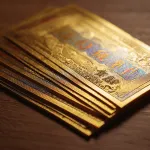Retirement should be your golden years—a time to enjoy the fruits of decades of hard work without financial worry. But as any Michigan retiree knows, the economic landscape has changed dramatically. Inflation erodes purchasing power, market volatility threatens nest eggs, and the pension security previous generations enjoyed is increasingly rare. In this uncertain environment, more Michigan retirees are discovering what wealthy families have known for centuries: gold and silver offer stability, wealth preservation, and portfolio protection that traditional investments simply cannot match.
If you’re among the approximately 17% of Michigan’s population aged 65 or older, you’ve likely worked hard to build your retirement savings through 401(k)s, IRAs, pensions, and Social Security. But are those assets truly protected? With Michigan’s average retirement income of just $55,444 annually and retirees needing $864,929 saved to live comfortably for the expected 15.6-year retirement period, every dollar counts. Precious metals can help ensure your hard-earned wealth maintains its purchasing power throughout your retirement years.
This comprehensive guide explains why Michigan retirees are turning to gold and silver, how precious metals fit into retirement portfolios, Michigan’s unique tax advantages for precious metals investors, and practical steps to get started.
Why Michigan Retirees Are Turning to Precious Metals
Michigan retirees face unique financial challenges that make precious metals particularly attractive. Understanding these challenges helps explain why gold and silver have become essential components of smart retirement planning.
Fixed Income Vulnerability to Inflation
Most Michigan retirees live on relatively fixed incomes from Social Security, pensions, and retirement account withdrawals. With the average retirement income of $55,444 annually and median household income for seniors around $44,000, there’s little margin for error when inflation strikes.
Recent years have demonstrated how quickly inflation can erode purchasing power. Groceries, utilities, healthcare, property taxes, and everyday expenses have risen dramatically. What seemed like adequate retirement savings just a few years ago may no longer stretch as far.
Gold and silver act as inflation hedges. When the dollar loses value due to inflation, precious metals typically increase in price, maintaining purchasing power. For Michigan retirees on fixed incomes, this protection is invaluable.
Real-World Example: A Michigan retiree with $100,000 in cash savings in 2020 has seen that money lose approximately 20% of its purchasing power due to inflation by 2025. If that same $100,000 had been invested in gold in 2020, it would have grown to approximately $150,000-160,000 by 2025—not only preserving purchasing power but actually gaining value.
Market Volatility and Limited Recovery Time
Unlike younger investors who can weather market downturns and wait for recovery, retirees don’t have time on their side. A major stock market correction during retirement can permanently impair financial security, especially if you’re forced to sell investments at depressed prices to fund living expenses.
The 2020 COVID crash, 2022 tech pullback, and 2023 banking turbulence reminded retirees that market stability is never guaranteed. Each downturn creates stress and potentially forces retirees to adjust their lifestyle expectations downward.
Precious metals provide portfolio diversification that reduces exposure to stock market fluctuations. Gold and silver often move independently of—or inversely to—stocks and bonds, providing stability when traditional markets stumble.
Michigan’s Retiree-Friendly Tax Environment
Michigan offers one of the most tax-friendly environments for retirees in the United States, and these advantages extend to precious metals investing:
No Tax on Social Security: Michigan doesn’t tax Social Security benefits, leaving more money available for investment and living expenses.
Retirement Income Tax Phaseout: Michigan is phasing out retirement income taxes through 2026. For those born between 1946-1966, 75% of eligible public and private retirement income is deductible in 2025, with full exemption coming in 2026.
Precious Metals Sales Tax Exemption: Michigan exempts gold, silver, and platinum bullion with 90%+ purity from the state’s 6% sales tax, making bullion purchases more affordable than in many other states.
Flat 4.25% Income Tax Rate: Michigan’s flat income tax means predictable tax planning for capital gains on precious metals sales.
These tax advantages make Michigan an ideal state for retirees to incorporate precious metals into their financial strategies.
Pensions and Social Security Aren’t Always Enough
While Michigan retirees may have pensions—particularly those who worked for automotive companies, school systems, or government—pension values erode over time without cost-of-living adjustments. A pension that seemed generous in 2010 doesn’t stretch as far in 2025.
Social Security provides a foundation, but average monthly benefits replace only about 40% of pre-retirement income. For Michigan retirees with median senior household income around $44,000, making ends meet requires careful financial management and strategic investment decisions.
Precious metals provide a supplemental store of value that isn’t dependent on corporate solvency, government promises, or market performance. Your gold and silver belong to you outright—no counterparty risk, no management fees eating away returns, just pure value preservation.
Healthcare Cost Concerns
Healthcare represents one of the largest and most unpredictable expenses in retirement. Medicare covers much, but not everything. Supplemental insurance, prescription drugs, dental care, and potential long-term care needs can quickly drain retirement savings.
Having a portion of retirement assets in precious metals provides liquidity and value stability when unexpected healthcare expenses arise. Gold and silver can be sold quickly when needed, providing access to capital without being forced to sell stocks at inopportune times.
Understanding Precious Metals as Retirement Assets
Before investing in gold and silver, Michigan retirees should understand what precious metals offer and how they differ from traditional retirement assets.
Gold: The Ultimate Store of Value
Gold has served as money and a store of value for over 5,000 years across virtually every civilization. This historical track record is unmatched by any paper currency, government, or financial institution.
Why Gold Works for Retirees:
Proven Wealth Preservation: Gold maintains purchasing power over centuries. An ounce of gold bought the same quality toga in ancient Rome as it buys a quality suit today.
Crisis Protection: During economic uncertainty, banking failures, currency devaluation, or geopolitical turmoil, gold prices typically rise as investors seek safety.
Portfolio Stabilizer: Gold often moves inversely to stocks and bonds, providing balance when traditional assets decline.
Globally Recognized: Gold is universally valued and easily convertible to cash anywhere in the world.
No Counterparty Risk: Physical gold ownership means you hold real value, not a promise from a bank, government, or corporation.
Gold prices reached historic highs above $3,500 per ounce in 2025, demonstrating continued strong demand amid economic uncertainty. Experts project gold could surpass $4,000 in the coming years as central banks continue accumulating gold reserves and individual investors seek protection.
Silver: The Affordable Precious Metal
Silver offers many of gold’s benefits at a much lower price point, making it accessible to retirees with more modest budgets. With silver trading at a fraction of gold’s price, Michigan retirees can accumulate more ounces and build positions gradually.
Why Silver Appeals to Retirees:
Affordability: At current prices, you can buy an ounce of silver for roughly $30-40 versus $3,500+ for gold, allowing smaller, more frequent purchases.
Industrial Demand: Silver has extensive industrial applications in electronics, solar panels, medical devices, and electric vehicles, creating demand beyond investment purposes.
Growth Potential: Silver tends to outperform gold during bull markets, offering potential for greater percentage gains.
Divisibility: Smaller denominations make silver more practical for moderate transactions if you ever need to liquidate portions of holdings.
Historical Value: Like gold, silver has served as money for millennia and maintains intrinsic value.
Many financial advisors suggest retirees hold both gold and silver for diversification within their precious metals allocation.
Platinum and Palladium: Alternative Options
While gold and silver dominate precious metals investing, platinum and palladium offer additional diversification. Both have industrial applications, particularly in automotive catalytic converters, creating demand from manufacturing sectors.
However, platinum and palladium markets are more volatile and specialized than gold and silver. For most Michigan retirees, focusing on gold and silver provides better stability and liquidity.
How Much Should Michigan Retirees Allocate to Precious Metals?
One of the most common questions retirees ask is: “How much of my portfolio should I hold in gold and silver?” Financial experts generally recommend precious metals should represent 5-20% of a diversified retirement portfolio, depending on individual circumstances.
The 5-10% Conservative Approach
Most financial advisors suggest retirees allocate 5-10% of their portfolio to precious metals for conservative protection. This allocation provides:
- Meaningful diversification benefits
- Inflation hedge without over-concentration
- Portfolio stability during market downturns
- Manageable position that doesn’t sacrifice income-producing assets
For a Michigan retiree with $300,000 in total retirement savings, a 5-10% precious metals allocation would mean $15,000-$30,000 in gold and silver—a meaningful hedge without dominating the portfolio.
The 10-20% Aggressive Approach
Retirees with stronger concerns about inflation, market volatility, or economic instability might choose a higher allocation of 10-20%. This approach:
- Provides substantial inflation protection
- Reduces overall portfolio volatility more significantly
- Offers greater crisis protection
- Still maintains diversification across asset classes
A Michigan retiree particularly concerned about purchasing power erosion might allocate $30,000-$60,000 of that $300,000 portfolio to precious metals.
Factors Influencing Your Allocation
Several factors should influence your precious metals allocation:
Age and Time Horizon: Younger retirees (65-70) might hold more gold and silver than those in their 80s, as longer time horizons allow for greater portfolio recovery potential.
Other Income Sources: Retirees with guaranteed pensions or substantial Social Security might allocate more to precious metals since they have stable income covering basic expenses.
Risk Tolerance: Conservative retirees uncomfortable with volatility might prefer 5-7% allocations, while those comfortable with price fluctuations might go to 15-20%.
Existing Assets: If your retirement portfolio is heavily weighted in stocks, precious metals provide valuable diversification. If you already own significant real estate, you might need less precious metals exposure.
Economic Outlook: Your perspective on inflation, government debt, dollar strength, and market valuations should influence how much protection you seek through precious metals.
Gold vs. Silver Ratio for Retirees
Within your precious metals allocation, how should you split between gold and silver? Common approaches include:
70% Gold / 30% Silver: Emphasizes stability and wealth preservation while including silver’s growth potential.
60% Gold / 40% Silver: Balanced approach providing good stability with meaningful silver exposure.
50% Gold / 50% Silver: Equal weighting for retirees who believe silver offers strong upside potential.
Most Michigan retirees favor gold-heavy allocations for maximum stability, with silver providing diversification and affordability.
Types of Gold and Silver Investments for Michigan Retirees
Michigan retirees can invest in precious metals through several methods, each with distinct advantages and considerations.
Physical Bullion: Coins and Bars
Owning physical gold and silver means you hold tangible assets you can see, touch, and store. This direct ownership appeals to many retirees who value the security of possessing actual metal rather than paper promises.
Popular Options for Michigan Retirees:
American Gold Eagles: The most popular gold coin in the United States, available in 1 oz, 1/2 oz, 1/4 oz, and 1/10 oz sizes. At 91.67% purity, they exceed Michigan’s 90% threshold for sales tax exemption.
Canadian Gold Maple Leafs: Featuring 99.99% pure gold, these coins from our neighbor to the north are highly liquid and tax-exempt in Michigan.
American Silver Eagles: The most recognized silver coin, containing 1 oz of 99.9% pure silver. Perfect for building silver positions affordably.
Silver Bars: Available in sizes from 1 oz to 100 oz, silver bars typically carry lower premiums than coins, making them cost-effective for accumulating larger positions.
Gold Bars: For retirees building substantial gold positions, bars from 1 oz to 1 kilo offer efficient value storage with lower premiums per ounce than coins.
Advantages of Physical Bullion:
- Direct ownership with no counterparty risk
- Tangible assets you control
- No management fees
- Privacy in transactions
- Can be passed to heirs easily
- Emergency liquidity if needed
Considerations:
- Requires secure storage (home safe or bank safe deposit box)
- May need insurance
- Buying and selling involves premiums above spot price
- Must verify authenticity when buying from unfamiliar sources
Precious Metals IRAs (Gold IRAs and Silver IRAs)
Precious metals IRAs allow retirees to hold physical gold and silver within tax-advantaged retirement accounts. These self-directed IRAs provide powerful benefits for Michigan retirees looking to protect retirement savings.
How Precious Metals IRAs Work:
- Open a self-directed IRA with a custodian specializing in precious metals
- Fund the account through contributions or rollover from existing IRA/401(k)
- Purchase IRS-approved gold and silver meeting purity requirements
- Metals are stored by IRS-approved depository (you can’t take personal possession)
- Grow tax-deferred (traditional IRA) or tax-free (Roth IRA)
- Take distributions starting at age 59½ without penalty
Benefits for Michigan Retirees:
Tax Advantages: Traditional gold IRAs provide tax-deferred growth; Roth gold IRAs offer tax-free growth. Given Michigan’s phase-out of retirement income taxes (full exemption by 2026), the timing is excellent for building precious metals IRA positions.
Portfolio Protection: Protect retirement accounts from market volatility and inflation without sacrificing tax advantages.
Rollover Flexibility: Transfer existing 401(k), 403(b), or IRA funds into a gold IRA without tax penalties.
Professional Storage: IRS-approved depositories provide secure, insured storage of your precious metals.
Inflation Hedge Within Retirement Accounts: Protect your largest retirement assets (IRAs and 401(k)s) with precious metals’ inflation-fighting power.
Considerations:
- Higher fees than traditional IRAs (custodian fees, storage fees, insurance)
- Cannot take personal possession while in IRA
- Required minimum distributions (RMDs) begin at age 73
- Early withdrawal penalties apply before age 59½
- Must use IRS-approved metals and custodians
For Michigan retirees with substantial IRA or 401(k) balances, precious metals IRAs offer powerful wealth protection while maintaining tax advantages.
Precious Metals ETFs
Exchange-traded funds (ETFs) that track gold and silver prices offer an alternative to physical ownership, providing exposure to precious metals through brokerage accounts.
Popular Precious Metals ETFs:
- SPDR Gold Shares (GLD)
- iShares Gold Trust (IAU)
- iShares Silver Trust (SLV)
- Aberdeen Standard Physical Silver Shares ETF (SIVR)
Advantages:
- Easy to buy and sell through brokerage accounts
- No storage or insurance concerns
- Highly liquid
- Can hold in existing IRA or taxable accounts
- Lower transaction costs than physical metal
Disadvantages:
- Don’t own physical metal (own shares of a trust)
- Annual management fees (typically 0.25-0.50%)
- Counterparty risk (dependent on fund management)
- May not track spot prices perfectly
- Can’t take physical delivery
For Michigan retirees who prioritize convenience and liquidity over physical possession, ETFs provide viable precious metals exposure.
Mining Stocks and Mutual Funds
Some retirees invest in gold and silver mining companies or precious metals mutual funds rather than metal itself. While these offer leverage to metals prices, they also introduce company-specific risks.
Advantages:
- Potential for higher returns than metal itself during bull markets
- Dividend income from some miners
- Easy to trade through brokerage accounts
Disadvantages:
- Company-specific risks (management, operations, accidents)
- May not correlate perfectly with metal prices
- More volatile than physical metals
- Don’t provide same crisis protection as physical ownership
Most financial advisors recommend retirees focus on physical metals or precious metals IRAs rather than mining stocks, as the goal is typically stability and protection rather than speculation.
Michigan-Specific Advantages for Retiree Precious Metals Investors
Michigan retirees enjoy several unique advantages when investing in gold and silver that make the Great Lakes State particularly attractive for precious metals investing.
Sales Tax Exemption Saves Money
Michigan exempts gold, silver, and platinum bullion with 90%+ purity from the state’s 6% sales tax. For retirees building precious metals positions, this exemption represents significant savings.
Real Savings Example: A Michigan retiree purchasing $20,000 in gold and silver would save $1,200 in sales tax compared to states without exemptions. That $1,200 can buy additional precious metals rather than going to taxes.
Virtually all investment-grade bullion—American Eagles, Canadian Maple Leafs, silver bars, and gold bars—meets Michigan’s 90% purity requirement for tax exemption.
Retirement Income Tax Phaseout
Michigan’s ongoing phase-out of retirement income taxes (reaching full exemption in 2026) creates excellent timing for Michigan retirees to build precious metals positions. When you eventually sell precious metals for profit, the capital gains will be subject to Michigan’s flat 4.25% rate—but with the retirement income tax exemption, many retirees will find their overall state tax burden significantly reduced.
This favorable tax environment makes Michigan one of the best states for retirees to implement precious metals investment strategies.
Proximity to Canada
Michigan’s border with Canada provides access to Canadian precious metals products, particularly Royal Canadian Mint coins and bars. CanAm Bullion’s associations with the Royal Canadian Mint mean Michigan retirees can easily access high-quality Canadian gold and silver products featuring 99.99% purity.
Given Canada’s reputation for producing exceptional precious metals products, Michigan’s geographic advantage shouldn’t be overlooked.
Active Precious Metals Community
Detroit, Grand Rapids, Ann Arbor, and other Michigan cities host active precious metals communities with established dealers, regular coin shows, and collector organizations. This infrastructure makes buying, selling, and learning about precious metals convenient for Michigan retirees.
Common Mistakes Michigan Retirees Should Avoid
While precious metals investing offers powerful benefits, several common mistakes can undermine results. Avoid these pitfalls:
Over-Allocating to Precious Metals
While gold and silver provide important portfolio protection, over-allocation can cause problems. Precious metals don’t generate income through dividends or interest, potentially creating cash flow challenges for retirees who need regular income.
Remember: Most experts recommend 5-20% precious metals allocation—meaningful but not dominant.
Buying from Unreliable Dealers
Not all precious metals dealers operate with the same integrity. Some charge excessive premiums, sell low-purity products, or create pressure sales tactics. Purchase from established, reputable dealers with verifiable credentials.
CanAm Bullion Advantages:
- Royal Canadian Mint certified
- A+ Better Business Bureau rating
- Transparent pricing
- No pressure sales tactics
- Serving Michigan investors with integrity
Neglecting Storage and Security
Physical precious metals require proper storage. Leaving significant gold and silver in unsecured locations invites theft. Consider:
- Quality home safes (fireproof and bolted down)
- Bank safe deposit boxes
- Professional vault storage
- Insurance coverage
Never advertise your precious metals holdings or storage locations.
Emotional Buying or Selling
Precious metals prices fluctuate. Panic selling during temporary price declines or emotional buying during price spikes can hurt long-term results. Approach precious metals as long-term holdings for wealth preservation rather than short-term trading vehicles.
Ignoring Purity Requirements
Remember Michigan’s 90% purity requirement for sales tax exemption. Purchasing gold or silver below 90% purity triggers the 6% sales tax unnecessarily. Stick with investment-grade bullion (typically 90% or higher) to maximize tax benefits.
Failing to Diversify Within Precious Metals
Don’t put all precious metals allocation into a single product. Diversify between:
- Gold and silver
- Coins and bars
- Different sizes (for flexibility when selling)
- Physical metals and precious metals IRA
Diversification within your precious metals holdings provides flexibility and risk management.
Not Planning for Liquidity
While precious metals are liquid assets, selling requires working with dealers who will buy back at prices below spot (to allow their profit margin). Plan ahead for liquidity needs rather than being forced to sell quickly at unfavorable prices.
Keep some retirement assets in truly liquid form (money market funds, short-term CDs) for emergency needs so you’re never forced to liquidate precious metals under duress.
Practical Steps for Michigan Retirees to Start Investing
Ready to add precious metals to your retirement portfolio? Follow these practical steps to get started wisely:
Step 1: Assess Your Financial Situation
Before investing in precious metals, understand your complete financial picture:
- Total retirement savings and assets
- Monthly income from all sources (Social Security, pensions, RMDs)
- Monthly expenses and lifestyle needs
- Emergency fund status
- Healthcare costs and insurance
- Debt obligations
- Estate planning goals
This assessment helps determine how much you can allocate to precious metals without compromising income needs or emergency preparedness.
Step 2: Determine Your Allocation Strategy
Based on your financial assessment, risk tolerance, and economic outlook, decide your precious metals allocation percentage and gold/silver ratio.
Sample Michigan Retiree Portfolio:
- Total Retirement Assets: $400,000
- Precious Metals Allocation: 10% ($40,000)
- Gold: 70% ($28,000)
- Silver: 30% ($12,000)
Adjust these numbers to fit your circumstances and comfort level.
Step 3: Choose Your Investment Vehicle
Decide whether you want:
- Physical bullion for direct ownership and control
- Precious metals IRA for tax-advantaged retirement account protection
- ETFs for convenience and liquidity
- Combination approach using multiple vehicles
Many retirees choose physical bullion for part of their allocation and precious metals IRAs for retirement accounts.
Step 4: Select a Reputable Dealer
Work with established, trustworthy precious metals dealers. CanAm Bullion serves Michigan retirees with:
- Competitive pricing on gold and silver
- Royal Canadian Mint certification
- A+ BBB rating
- No pressure sales
- Expert guidance for retirees
- Products meeting Michigan’s tax exemption requirements
- Secure shipping to Michigan addresses
Call +1 (844) 828-4653 to speak with our precious metals specialists about your retirement investment goals.
Step 5: Start with Quality Products
For your initial precious metals purchases, focus on highly liquid, recognized products:
Gold Options:
- American Gold Eagles (1 oz or fractional)
- Canadian Gold Maple Leafs (1 oz)
- Gold bars from recognized refiners (1 oz or larger)
Silver Options:
- American Silver Eagles (1 oz)
- Canadian Silver Maple Leafs
- Silver bars (10 oz or 100 oz for better value)
These products offer excellent liquidity, tax exemption in Michigan, and universal recognition.
Step 6: Arrange Secure Storage
Before your precious metals arrive, arrange proper storage:
- Purchase a quality home safe (fireproof, bolted)
- Rent a safe deposit box at your Michigan bank
- Consider professional vault storage for larger holdings
- Ensure adequate insurance coverage
Never leave significant precious metals unsecured.
Step 7: Document Your Purchases
Keep detailed records of all precious metals purchases:
- Purchase receipts and invoices
- Product descriptions and quantities
- Purchase prices (cost basis for taxes)
- Dates of acquisition
- Storage locations (secure this documentation)
Proper documentation is essential for estate planning, insurance claims, and capital gains tax calculations when you eventually sell.
Step 8: Monitor but Don’t Obsess
Check precious metals prices periodically but avoid obsessing over short-term fluctuations. Remember, you’re holding gold and silver for long-term wealth preservation, not short-term trading profits.
Set a schedule to review your overall portfolio (including precious metals) quarterly or semi-annually, adjusting allocation if it drifts significantly from target percentages.
Step 9: Consider Dollar-Cost Averaging
Rather than investing your entire precious metals allocation at once, consider dollar-cost averaging—purchasing fixed dollar amounts at regular intervals (monthly or quarterly).
Example: Instead of buying $40,000 in precious metals immediately, purchase $2,000 monthly for 20 months. This approach:
- Reduces timing risk
- Averages out price fluctuations
- Makes large allocations more manageable psychologically
- Allows you to learn gradually
Step 10: Review and Adjust Periodically
As economic conditions change and your retirement evolves, periodically review your precious metals holdings:
- Has your allocation drifted from target percentages?
- Have your income needs changed?
- Do economic conditions warrant increased or decreased precious metals exposure?
- Are there tax planning opportunities related to precious metals sales?
Annual or semi-annual reviews ensure your precious metals strategy continues serving your retirement goals effectively.
Conclusion: Protecting Your Michigan Retirement with Precious Metals
Retirement should provide freedom, security, and peace of mind—but economic uncertainty, inflation, and market volatility threaten those goals. For Michigan retirees managing finite savings with limited time to recover from financial setbacks, precious metals offer proven protection.
Gold and silver have preserved wealth for 5,000 years across civilizations, economic systems, and crises. While governments, currencies, and financial institutions rise and fall, precious metals maintain intrinsic value. This timeless reliability makes them ideal for retirees who need stability above all else.
Key Takeaways for Michigan Retirees:
- Inflation Protection: With fixed incomes vulnerable to rising costs, precious metals maintain purchasing power when dollars lose value
- Portfolio Diversification: Gold and silver move independently of stocks and bonds, reducing overall portfolio volatility
- Michigan Tax Advantages: Sales tax exemptions on bullion and retirement income tax phaseout make Michigan excellent for precious metals investing
- Appropriate Allocation: Most experts recommend 5-20% of retirement portfolios in precious metals for meaningful protection without over-concentration
- Multiple Investment Options: Choose physical bullion, precious metals IRAs, or ETFs based on your priorities
- Long-Term Perspective: Hold precious metals for wealth preservation, not short-term trading
- Quality and Authenticity Matter: Work with reputable dealers offering recognized products
Michigan’s combination of retiree-friendly tax policies, active precious metals community, and proximity to Canadian products makes the Great Lakes State an ideal location for retirees to implement precious metals strategies.
Take Action to Protect Your Retirement
If you’re a Michigan retiree concerned about inflation eroding your savings, market volatility threatening your nest egg, or simply want greater portfolio stability, precious metals deserve serious consideration.
CanAm Bullion specializes in helping Michigan retirees navigate precious metals investing with:
- Expert Guidance: Our specialists understand retiree needs and concerns
- Quality Products: Gold coins, silver bars, and platinum products meeting Michigan’s tax exemption requirements
- Competitive Pricing: Low premiums mean more metal for your money
- Royal Canadian Mint Certified: Access to exceptional Canadian precious metals products
- A+ BBB Rating: Proven trustworthiness and customer satisfaction
- No Pressure: Educational approach respecting your timeline and decisions
- Secure Shipping: Fully insured delivery to your Michigan address
Browse our selection of retirement-appropriate precious metals, or call +1 (844) 828-4653 to speak with a precious metals specialist who understands Michigan retiree needs.
Your decades of hard work deserve protection. Gold and silver can help ensure your retirement years remain truly golden.
Disclaimer: This article provides educational information about precious metals investing for Michigan retirees and should not be considered investment advice. Precious metals prices fluctuate, and past performance doesn’t guarantee future results. We recommend Michigan retirees consult with qualified financial advisors regarding their specific circumstances, tax situations, and investment goals before making precious metals investment decisions.

CEO and Founder of CanAm Bullion has been dedicated to delivering exceptional value to Canadians since 2017. Driven by a mission to empower Canadians with expert investment advice and education, he has positioned CanAm Bullion as a trusted resource for those seeking to enhance their portfolios with precious metals. Under Michael’s leadership, the company has become synonymous with reliability, knowledge, and dedication, helping Canadians achieve greater financial stability and long-term success.






Share This Article
Choose Your Platform: Facebook Twitter Google Plus Linkedin